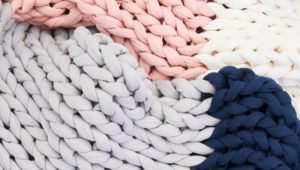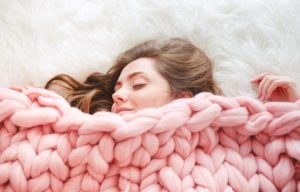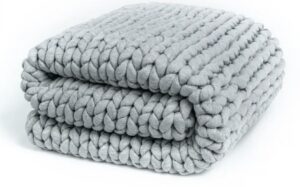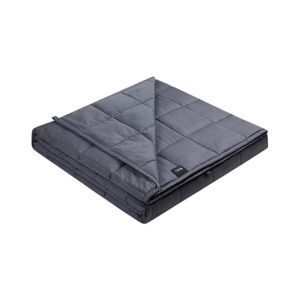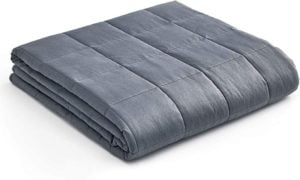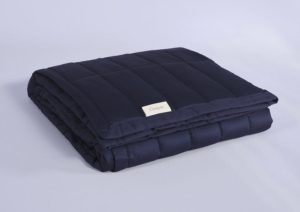Are Weighted Blankets Hot?
Due to the nature of weighted blankets and their construction, they may be hotter than standard blankets and comforters. However, a few styles, such as knitted weighted blankets, are designed for airflow. Additionally, some cooling weighted blankets use materials engineered to prevent overheating.
Weighted blankets are a popular addition to many people’s bedrooms. Sleepers often feel they enhance comfort and, in some cases, reduce anxiety and stress. But some sleepers worry that weighted blankets may trap too much heat. Ultimately, the warmth of a weighted blanket depends on its materials and construction. Some weighted blankets retain heat, while others promote a cooling sensation.
We’ll take a look at knitted and duvet-style weighted blankets, discussing how their distinct designs affect heat retention. We’ll also explain the potential benefits of using a weighted blanket.
How Weighted Blankets Are Made
Weighted blankets may use a duvet-style or knitted construction. Knitted weighted blankets consist of chunky yarn for greater air circulation. Duvet-style weighted blankets typically contain glass microbeads, plastic pellets, or ball bearings encased in a fabric shell.
Knitted Weighted Blankets
Knitted weighted blankets typically use dense yarn to give the blanket its trademark heft. This design provides even weight distribution, but it also leaves generous gaps for air to circulate.
Many knitted weighted blankets consist of cotton yarn, a highly breathable material. Others use polyester, which is usually more affordable.
Duvet-Style Weighted Blankets
Duvet-style weighted blankets are the more common, traditional variety. They use weighted fill, which may include glass beads, plastic beads, ball bearings, or other materials. Many duvet-style weighted blankets also use a layer of batting so that the sleeper does not feel the texture of the weighted material.
An outer shell holds the fill in place. The shell fabric may consist of cotton, polyester, or a blend. In some cases, you can also use a removable duvet cover for easy cleaning.
Knitted vs. Duvet-Style Weighted Blankets
Knitted and duvet-style weighted blankets vary in their construction, performance, pricing, and care. While weighted blankets with similar designs often share key characteristics, differences also exist between individual models.
| Knitted Weighted Blankets | Duvet-Style Weighted Blankets | |
|---|---|---|
| Construction | Knitted weighted blankets traditionally use an open construction with dense, chunky yarn for even weight distribution and superior breathability. | Duvet-style weighted blankets generally contain weighted fill and a buffer of batting inside a fabric shell. |
| Heat | Because knitted weighted blankets have an open design that allows air circulation, they usually do not retain much heat. | Some duvet-style weighted blankets trap heat, but this varies depending on the material. Those constructed of cotton and glass beads tend to be cooler and less insulating than models that use synthetic materials. |
| Weight Options | Knitted weighted blankets generally range from 5 to 30 pounds. | Duvet-style weighted blankets typically weigh from 5 to 30 pounds. |
| Breathability | Open-knit patterns allow for ample airflow, making knitted weighted blankets a good choice for breathability. | Breathability for duvet-style weighted blankets depends on the materials. Natural materials, like cotton and wool, tend to allow more air circulation. |
| Cost | Knitted weighted blankets typically range from $150 to $300 depending on their weight, size, and materials. | Duvet-style weighted blankets are more widely available, so they come in a broader range of prices. Expect to pay anywhere from $30 to $300 depending on the weight, size, and materials. |
| Care | Care depends on the blanket’s materials and construction. Most can be either machine-washed, hand-washed, or dry-cleaned. Always consult the care instructions. Note that while some knitted weighted blankets are machine-washable, they may be too heavy for your home machine. | Care instructions for duvet-style weighted blankets vary based on their materials and construction. Some are machine-washable if you have access to a washer with a high weight capacity, while others can be dry-cleaned or spot-cleaned. Some duvet styles also have a removable cover you can launder separately to freshen up your bedding more easily. |
Weighted Blankets and Heat
Weighted blankets are designed to hug the body, which can reduce airflow and trap warmth. But like other bedding options, such as comforters, duvets, and traditional blankets, a weighted blanket’s materials and construction determine the level of insulation. Just as there are cooling comforters, you can find weighted blankets appropriate for warmer weather.
Are Weighted Blankets Breathable?
Some weighted blankets are breathable, which can enhance their temperature regulation. Air circulation allows heat to escape so that it isn’t trapped against the sleeper’s body. This may be a good choice for people who tend to sleep hot but like the hug of a weighted blanket.
The level of breathability depends on the blanket’s construction. Knitted weighted blankets have open designs, allowing ample airflow between the yarn. Duvet-style weighted blankets can also be made from breathable materials, such as cotton and wool. To further limit insulation, a cooling duvet-style weighted blanket may use a thinner layer of batting.
Cooling Weighted Blankets
Cooling weighted blankets are specifically designed to promote breathability and reduce the risk of overheating. Many knitted weighted blankets are marketed as cooling due to their exceptional air circulation. Meanwhile, most duvet-style cooling blankets use glass beads as their weighted fill because they don’t retain a lot of heat.
Regardless of the blanket design, the type of fabric also plays a role in temperature regulation. Cooling weighted blankets often use highly breathable materials, such as cotton, wool, viscose or lyocell derived from bamboo, or Tencel derived from eucalyptus. Wool, lyocell, and Tencel are also popular for their moisture-wicking properties, which can be beneficial for sleepers prone to sweating.
The Ideal Sleep Temperature
Most doctors suggest a bedroom temperature between 65 and 68 degrees for sleeping. Using some sort of blanket or covers in a cool environment is also recommended. However, the most comfortable sleep temperature is somewhat subjective.
The right temperature for sleeping is important for creating a calm atmosphere to fall asleep and stay asleep. Too high a temperature can contribute to poor sleep, including waking up during the night. A high temperature can also lead to decreased slow-wave sleep, otherwise known as deep sleep.
Benefits of Weighted Blankets
Weighted blankets are designed to promote calmness through deep pressure stimulation. Some studies suggest a wide array of potential benefits of weighted blankets. However, research is limited.
As with any product, always be cautious of medical claims from manufacturers. Not all sleepers benefit from a weighted blanket. Consult with a healthcare professional if you have any concerns.
Heat Retention
Cold sleepers or those who sleep in a cold environment may experience sleep problems, such as a decrease in REM sleep, which may activate stress hormones in the body. For these individuals, insulating weighted blankets may be beneficial for added warmth.
Comfort and Security
Some say weighted blankets provide a comfortable swaddling effect. Similar to how newborns are swaddled to improve sleep, adults may feel weighted blankets provide a similar sensation.
Deep Pressure Stimulation
Weighted blankets use deep pressure stimulation intended to improve sleep quality. Deep pressure stimulation is a therapeutic method that applies pressure to create a sense of calmness and well-being. Research on this therapy shows that extra pressure stimulates the release of mood-boosting hormones, such as serotonin and dopamine, which promotes calm.
Stress and Anxiety Relief
Some studies show reductions in stress and anxiety through the use of a weighted blanket. An overactive nervous system is linked to anxiety and other physiological arousal symptoms. With the pressure of a weighted blanket, this arousal may decrease, providing anxiety relief.

Still have questions? Ask our community!
Join our Sleep Care Community — a trusted hub of sleep health professionals, product specialists, and people just like you. Whether you need expert sleep advice for your insomnia or you’re searching for the perfect mattress, we’ve got you covered. Get personalized guidance from the experts who know sleep best.

